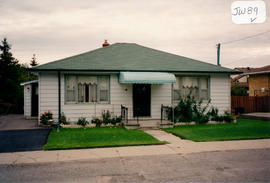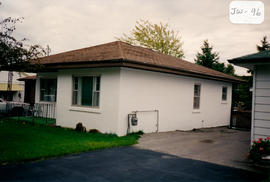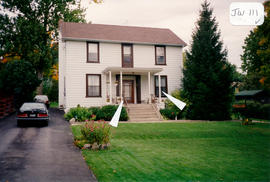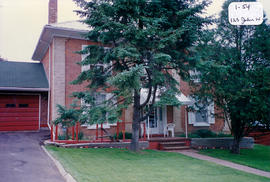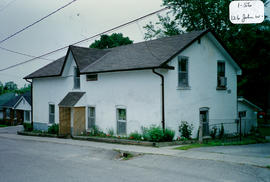81 John Street West - Bradford Presbyterian Church
- CA BWGPL GJ-HB-2017-04-05-17
- Item
- 1996
Part of George Jackson fonds
The Bradford Presbyterian Church was once located at 81 John St. West (on the northwest corner of Church and John Streets). A Presbyterian church in Bradford dates back to 1856. The original frame building was built on this site and used until 1893. At that time it was sold to the Anglican Church and moved a short distance north to be used as the Parish Hall. The structure seen in this photo (from 1996) was designed in the Romanesque style by Siddell Baker Architects in Toronto. It was constructed in 1893 for $5,000 by local builder Dougald (George) MacDonald. George was able to do short-hand blueprints and he was also the Sunday school teacher. The church pipe organ was installed in 1915 (with a portion of it funded by the Carnegie Foundation). A seven-foot section of interior, cornice molding fell off and crashed through some front seating and the floor and landed in the basement in 1937. It was rediscovered years later in George MacDonald’s barn.
The 1½-storey building had a modified, cruciform plan with an apse, narthex, and square and polygonal entrance towers. There was a steeply-pitched, gable roof with pyramidal and polygonal roofs on the towers. This structure was a complex massing of heavy, simple forms, each of which had a clear function. The main entrance was through a large, round-arched doorway with a crescent-shaped transom light and a heavy, panelled, wood door. It was set into a high, square tower at the southeast corner of the church and it marked the site as a landmark within the town. Tall, narrow, window openings had thin windows with a vertical emphasis. Some secondary windows were set in rectangular openings (but with the same narrow proportions). Windows having round-arched openings of various sizes in groups, and as singles, lit the nave. The simplicity of this church and the lack of typical Romanesque Revival details such as heavy, stone stringcourses and lintels gave the church a Norman feel with its squared tower and massive walls. Square pinnacles topped the four corners of the entrance tower. The building had masonry construction with brick cladding and a cut-stone foundation. Len Saint, a local stone mason and brick layer, did the plastering for the church. There were metal panels on the steeple and tower roofs. According to the 2000 inventory, the church was in excellent condition with many original features.
The congregation moved to St. John’s Presbyterian Church which was located on the Middleton Sideroad (circa 2004). Trinity Anglican Church purchased the old Presbyterian Church building and land in 2004 and the building was demolished in 2005 to provide additional parking for the congregation of Trinity Anglican Church. (1, 3, 4, Trinity Anglican Church Bradford website)
George Jackson


